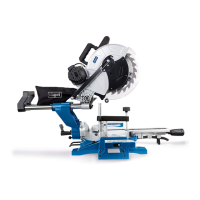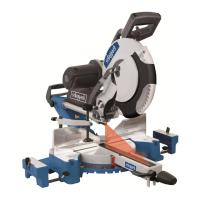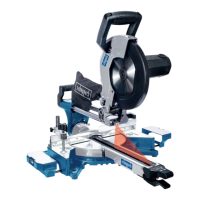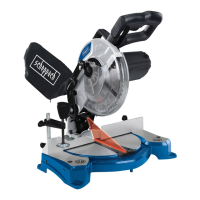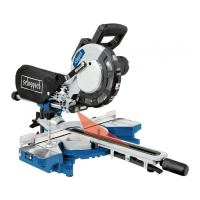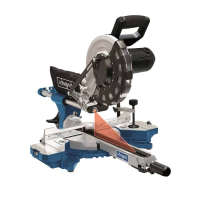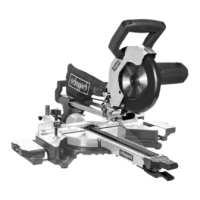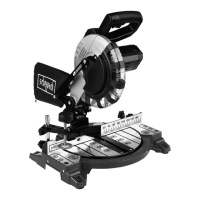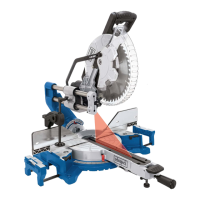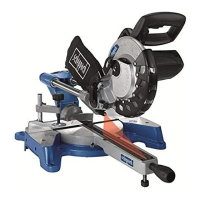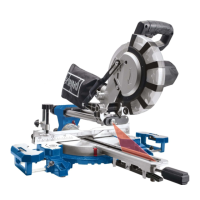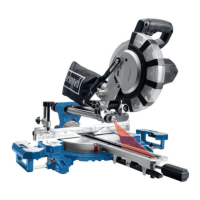www.scheppach.com / service@scheppach.com / +(49)-08223-4002-99 / +(49)-08223-4002-58
GB
|
35
• In the table circular saw mode, use a riving knife
and set it up properly; (Fig. 20)
• The machine must not be used for slotting (insert
grooves);
• During transport, the upper part of the saw blade
must be covered, e.g. by the upper guard, or the
saw blade must be in its lowest position;
• In the table circular saw mode, the lower saw safety
device must be used and set up properly.
m WARNING
• The vibration levels during operation of the power
tool can deviate from the specied vibration levels,
depending on the application of the power tool.
m WARNING
• Restrict the work time and reduce the actual oper-
ating time to lower the risk of vibration.
Remaining risks
Even when you use the machine for its intended pur-
pose, certain risks remain that cannot be completely
avoided. Based on the construction and set-up of the
machine, the following issues may occur:
• Contact with the saw blade in an uncovered area
of the saw
• Touching the rotating saw blade (cut)
• Recoil of work pieces and ejection of work piece
parts
• Saw blade breakage
• Ejection of faulty carbide saw blade parts
• Hearing damage when not using the required hear-
ing protection
• Harmful emission of wood dust when the machine
is used in a closed room
• Risk of injury during tool replacement
The following factors affect noise emission:
1. material to be cut
2. type of saw blade
3. feed force
The following factors affect dust development:
1. worn saw blades
2. dust extraction units with an air speed of less than
20 m/s
3. work piece not guided properly
Working on particular timber such as beech and MDF
can cause dangerous dust during sawing.
Therefore, a dust extraction unit must be used.
2) Maintenance and care
• Observe the manufacturer‘s notices concerning
possible noise reduction (e.g. using saw blades
which have been constructed for lower noise pol-
lution, and saw blade and machine maintenance).
• Machine faults, including guards or saw blades,
must be resolved as soon as they are detected.
3) Working safely
• Select a saw blade suitable for the material you are
cutting;
• Never use the saw for cutting materials other than
those recommended by the manufacturer;
• The oor surrounding the machine must be level,
clean and free from loose material such as wood
chippings and offcuts;
• Make sure the room and your work area are well lit;
• Comply with the instructions for replacing the saw
blade.
m WARNING
• In the circular saw and mitre saw mode, the safety
devices have to be returned to their proper position.
• In the table circular saw mode, a push stick or a
push block with handle has to be used in order to
prevent the operator getting too close to the saw
blade with his/her hand when working.
• The operator must be trained sufciently in the set-
up, use and operation of the machine;
• Ensure that the arm of the saw is secured properly
when cutting diagonally;
• Ensure that the arm of the saw is secured prop-
erly in the work position when in table circular saw
mode;
• Before leaving the work area, turn off the saw;
• Ensure that the circular saw table is secured at the
selected height;
• Only ever use saw blades which have been sharp-
ened properly. Do not exceed the maximum rota-
tional speed specied on the saw blade;
• Make sure you only use spacers and spindle rings
which are suitable for the intended purpose speci-
ed by the manufacturer;
• If the machine is equipped with a laser, this laser
must not be replaced by a laser of another type.
Repairs must be carried out by the laser manufac-
turer or an authorised representative;
• Ensure that the upper part of the saw blade is com-
pletely enclosed when in mitre saw mode;
• Replacement and alignment of the saw blade have
to be carried out properly;
• Make sure that the machine, if possible, is secured
to a work bench or a table.
• Do not remove offcuts or other work piece parts
from the cutting area while the machine is running
and the blade has not yet come to a standstill;
